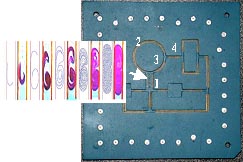MAGNETO-HYDRODYNAMIC NETWORKS
The networks’ basic building blocks are conduits equipped with two electrodes deposited along opposing walls. When a prescribed potential difference is applied across each electrode pair, it induces current in the liquid (assumed to be at least weakly conductive). The entire device is either subjected to an external uniform magnetic field or fabricated within a magnetic material. By judicious application of the potential differences at various network branches, one can direct liquid flow along any desired path without any mechanical pumps or valves. Ideas of linear graph theory are extended to allow one to determine the flow rates in various branches as functions of the applied fields and to determine the control variables needed to achieve desired flow paths. Equipped with internally located electrodes, the network branches can double as stirrers capable of inducing chaotic advection. Prototype devices have been fabricated with low temperature, co-fired ceramic tapes (LTCC). LTCC provide a rapid, low-cost prototyping medium for the fabrication of micro-fluidic systems and components.
A prototype of a magneto-hydrodynamic fluidic network:
Briefly, conduit 1 doubles as a stirrer. The insert depicts experimental observations and theoretical predictions of the stirring of a dye drop. Once the reagents are stirred, they are pumped into the torus (conduits 2-3). The electrodes are then re-programmed to circulate the fluid around the torus (2-3) a desired number of times. Various regions of the torus can be maintained at different temperatures, allowing thermal cycling and potentially PCR. Once the amplification is completed, the electrodes are reprogrammed and the fluid is channeled either back to conduit 1 or on to conduit 4 for further processing. By changing the polarity of the electrodes, one can readily alter the direction of the flow.
MAGNETO-HYDRODYNAMIC STIRRERS
Magneto-hydrodynamics provides us with a convenient means for stirring liquids. By appropriate patterning of the electrodes, one can induce forces in different directions and generate complex flow patterns. By alternating the potential difference between various groups of electrodes, chaotic advection and effective stirring are achieved. Various stirrers were modeled, fabricated, and tested. Each branch has two individually controlled electrodes positioned along opposing walls and additional disk-shaped electrodes deposited in the conduit’s interior away from its sidewalls. When one applies a potential difference between a disk-shaped electrode and two wall electrodes acting in tandem, circulatory motion is induced in the conduit. When the potential difference alternates periodically across two or more such configurations, complicated (chaotic) motions evolve. As the period of alternation increases, so does the complexity of the flow.
When a potential difference is applied among the electrodes denoted with capital letters, regular cellular convection ensues in the cavity. When the potential difference is alternately applied among the electrodes denoted with capital letters and the electrodes denoted with lower case letters, chaotic advection ensues. The left and right columns correspond, respectively, to theoretical predictions and flow visualization experiments.
PUBLICATIONS
- Bau, H., H., Zhong, J., and Yi, M., 2001, A Minute Magneto Hydro Dynamic (MHD) Mixer, Sensors and Actuators B, 79/2-3, 205-213.
- Bau, H., H., 2001, A Case for Magneto-hydrodynamics (MHD), IMECE 2001, MEMS 23884 Symposium Proceedings, N.Y., Nov 2001
- Zhong, J., Yi, M., and Bau, H., H., 2002, A Magneto-Hydrodynamics (MHD) Pump Fabricated with Ceramic Tapes, Sensors and Actuators A Physical, 96, 1, 59-66.
- Yi, M., Qian, S., and Bau, H., H., 2002, A Magneto-hydrodynamic (MHD) Chaotic Stirrer, J. Fluid Mechanics, 468, 153-177.
- Qian, S., Zhu, J., and Bau, H. H., 2002, A Stirrer for Magneto-Hydrodynamically Controlled Micro Fluidic Networks, Physics of Fluids, 14 (10): 3584-3592.
- Bau. H., H., Zhu, J., Qian, S., Xiang, Y., 2002, A Magneto-Hydrodynamic Micro Fluidic Network, IMECE 2002-33559, Proceedings of IMECE’02, 2002 ASME International Mechanical Engineering Congress & Exposition, New Orleans, Louisiana, November 17-22, 2002.
- Bau, H., H., Zhu, J., Qian, S., and Xiang, Y., 2003, A Magneto-Hydrodynamically Controlled Fluidic Network, Sensors and Actuators B: Chemical, 88, 205-216.
- Xiang, Y. and Bau, H. H., 2003, Complex Magneto Hydrodynamic, Low Reynolds Number Flows, Physical Review E, 68, 016312-1 – 016312-11
- Qian, S. and Bau, H., H., 2005, Magneto-hydrodynamic Stirrer for Stationary and Moving Fluids, Sensors and Actuators B: Chemical, 106, 859-870.
- Qian S., and Bau, H. H., 2005, Magneto-Hydrodynamic Flow of RedOx Electrolyte, Physics of Fluids, 17, 067105, 1-12.
- Qian, S., Chen, Z., Wang, J., and Bau, H., H., 2006, Electrochemical Reaction with RedOx in Toroidal Conduits in the Presence of Natural Convection, J. Heat and Mass Transfer 49, 3968-3976.
- Qian, S., and Bau, H., H., 2009, Magneto-Hydrodynamics Based Microfluidics, Mechanics Research Communications, 36, 10-21. doi:10.1016/j.mechrescom.2008.06.013
- Mian Qin and Haim H. Bau, 2011, When MHD-Based Microfluidics is Equivalent to Pressure-Driven Flow, Micro and Nano Fluidics 10, (2), 287-300 (DOI: 10.1007/s10404-010-0668-2)
- Qian, S., Qin, M., Bau, H., H., 2011, Applications of Magnetohydrodynamics in Microfluidics, Microfluidics and Nanofluidics Handbook: Physics and Transport Phenomena (S. K. Mitra and S. Chakraborthy, eds.), CRC Press, pp 155-175.
- Qin Mian and Bau, H. H., 2012, Magnetohydrodynamic Flow of a Binary Electrolyte in a Concentric Annulus, Physics of Fluids 24, 037101. http://dx.doi.org/10.1063/1.3689187.

